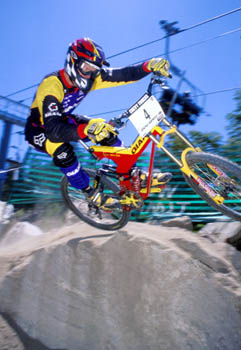
|
Home Pictures Links Send Feedback Technique: Climbing Descending Cornering Shifting Braking |
 |
DESCENDING Before starting a descent, level your pedals out horizontally so that they are parallel to the ground. During your descent, scan the trail ahead of you. This means look 10-20 feet in front and scan the trail for obstacles or sections that may cause problems. Be aware! Never concentrate on what you're trying to avoid, instead focus on a path that looks best for you. In most cases, what your eyes see is where your bike is going to go. Shift to the middle or largest chain ring when descending. This will increase tension on the chain and prevent the dreaded chainslap. To prevent a dreaded endo over the handlebars; which happens when your weight is too far forward, keep your weight back off the saddle and your pedals level. The steeper the trail, the further back and closer to the rear wheel you go. In some extreme cases, you may even need to get all the way off the back of the saddle. Always keep your entire body relaxed and loose. Don't make a death grip and stiffen all your muscles in your arms. Relax and let the bike sort of "float" below you. Bend your knees and use them to absorb the shocks of the hill. Braking is crucial when descending. You should use enough front brake to help keep your speed under control, but not so much that when your bike hits an obstacle you come to a halt, or a slide. Use the rear brake until it begins to slide or skid, then let it off bit to regain control. When cornering during a descent, always use your brakes before you enter the turn, not during. This allows you to maintain control on your turn, yet accelerate out of it. Start off slow if you are unsure of your capabilities. NEVER DO IT IF YOU KNOW YOU CAN'T, even if you think you're slick. |